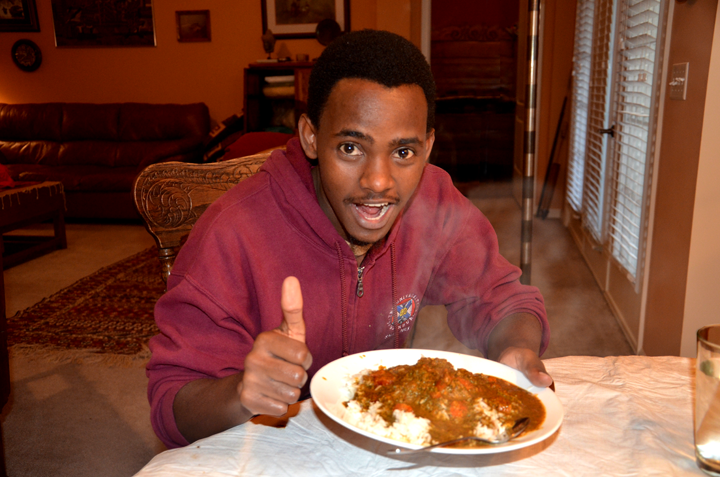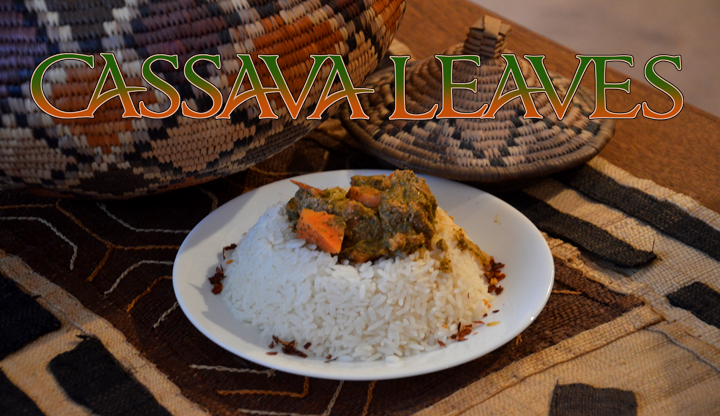When my friend from Rwanda, by way of
Earth University in Costa Rica, rolled into town during my mural
project, I was sure of two things. He was going to paint some on
my mural at Tremont Elementary, and we were going to eat African.
I was right on both counts. Gerard joins the ranks of five people
who have painted with me in two or more countries.
I wasn't sure what we were going to eat. Rwanda isn't on my list of visited countries - yet. I'm fully hoping and praying that someday Gerard Ndayishimiye will be the Minister of Agriculture in Rwanda. Then, he can bring me to Africa to paint educational murals across the land. It doesn't matter at the moment that this isn't Gerard's dream. He has time to change his mind about the future.
In the mean time, we were eating something African. And, the first thing Gerard said we needed was peanuts. In West Africa, peanuts are called "ground nuts". They were used in some Liberian dishes, but none that I really liked. I kept my mouth shut about this and my hopes high.
The next thing on Gerard's list was cassava leaves. Ndayishimiye! Gerard's last name means "thank God" in Kinyarwanda. And at that moment, the recipe was saved. It was a guaranteed success. For you see, cassava leaves were my favorite dish when I lived in Africa. Gerard refused to refer to the recipe as traditional because it was the first time he ever made it. So, it may not be completely traditional, but Ndayishimiye, it was so delicious.
I wasn't sure what we were going to eat. Rwanda isn't on my list of visited countries - yet. I'm fully hoping and praying that someday Gerard Ndayishimiye will be the Minister of Agriculture in Rwanda. Then, he can bring me to Africa to paint educational murals across the land. It doesn't matter at the moment that this isn't Gerard's dream. He has time to change his mind about the future.
In the mean time, we were eating something African. And, the first thing Gerard said we needed was peanuts. In West Africa, peanuts are called "ground nuts". They were used in some Liberian dishes, but none that I really liked. I kept my mouth shut about this and my hopes high.
The next thing on Gerard's list was cassava leaves. Ndayishimiye! Gerard's last name means "thank God" in Kinyarwanda. And at that moment, the recipe was saved. It was a guaranteed success. For you see, cassava leaves were my favorite dish when I lived in Africa. Gerard refused to refer to the recipe as traditional because it was the first time he ever made it. So, it may not be completely traditional, but Ndayishimiye, it was so delicious.
Ndayishimiye
for Cassava Leaves
Gerard Ndayishimiye
Gerard Ndayishimiye
Rice:
| enough rice for your friends 1/4 onion 1/4 green bell pepper |
1 tablespoon of oil
salt and pepper to taste
|
If you eat your rice like most of my
friends in Africa, you prepare a small mountain of rice per
person. You are allowed, however, to cut down that amount if you
must. Now, almost all rice I have ever seen prepared in that part
of the world was exclusively just white rice. So, I was not just a
little interested when I saw Gerard slice up some onion and bell pepper
to cook with the rice. A little variety is always a good thing.
This rice was prepared in a rice cooker. Ndayishimiye for that as well! Pour in some water, toss in the rice and veggies, and let that little machine perform it's magic until the time automatically goes off. If you aren't going to use some kind of instant rice, then this is the way to go.
This rice was prepared in a rice cooker. Ndayishimiye for that as well! Pour in some water, toss in the rice and veggies, and let that little machine perform it's magic until the time automatically goes off. If you aren't going to use some kind of instant rice, then this is the way to go.
Cassava Leaves Sauce:
| 2 pounds beef 1 cup of peanuts 2 Tbs oil
1/4 onion
1/4 green bell pepper |
1 tomato
1/2 can tomato paste (6 oz)
peanut sauce
2 packets cassava leaves
hot pepper to taste
|
Cut up your meat into the size you like
to eat. Then, boil the beef in water until the meat is
cooked. Remove the beef and save all of that water.
Toss the peanuts in a blender. You're about to make some kind of peanut butter. It won't have all the sugar you're used to, but it's what is needed for the recipe. Add two cups of water into the mix and hit the on switch. If you use water from the boiled meat, you'll add additional flavor. Two cups will make it watery enough to blend in the machine, but Gerard added an additional cup of beef broth to the mixture when he was ready to mix all ingredients.
In a large soup pot, fry up your beef in oil. After it has cooked a minute, add the diced onion and bell pepper to the mix. Next, dice up a tomato and add the tomato paste. Stir in your peanut sauce. This gives the dish such a delightful creamy texture.
The cassava leaves we found were frozen in packets about the size of a slice of bread. I broke them up in pieces, added water and whirled them around in the blender. By the time the leaves were all broken up, the entire blender was filled. All of that was poured into the mix in the soup pot.
Toss the peanuts in a blender. You're about to make some kind of peanut butter. It won't have all the sugar you're used to, but it's what is needed for the recipe. Add two cups of water into the mix and hit the on switch. If you use water from the boiled meat, you'll add additional flavor. Two cups will make it watery enough to blend in the machine, but Gerard added an additional cup of beef broth to the mixture when he was ready to mix all ingredients.
In a large soup pot, fry up your beef in oil. After it has cooked a minute, add the diced onion and bell pepper to the mix. Next, dice up a tomato and add the tomato paste. Stir in your peanut sauce. This gives the dish such a delightful creamy texture.
The cassava leaves we found were frozen in packets about the size of a slice of bread. I broke them up in pieces, added water and whirled them around in the blender. By the time the leaves were all broken up, the entire blender was filled. All of that was poured into the mix in the soup pot.
Now, I understand that some people
cannot locate cassava leaves and others might not want to try. I
promise you that this dish would be delicious with or without the
cassava leaves. It's your choice, but I will always add those
leaves.
If you ate this dish prepared in West Africa, your mouth would be on fire. Tears would stream down your face and your nose would run. There is that much hot pepper added to the recipe, every time, every meal, every day. I learned in the preparation of this meal that East Africans don't eat with so much fire. It's common to add pepper on the side so you can assault your taste buds to your own liking. Gerard added a sprinkling of hot pepper to the dish. It was not enough to even taste and not one tear was shed, except for perhaps when the dish was finished.
If you ate this dish prepared in West Africa, your mouth would be on fire. Tears would stream down your face and your nose would run. There is that much hot pepper added to the recipe, every time, every meal, every day. I learned in the preparation of this meal that East Africans don't eat with so much fire. It's common to add pepper on the side so you can assault your taste buds to your own liking. Gerard added a sprinkling of hot pepper to the dish. It was not enough to even taste and not one tear was shed, except for perhaps when the dish was finished.

